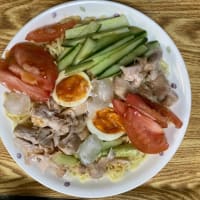学術論文に触れさせる課題はなかなかいいですよ。たとえば以下の論文、人間国宝の照喜名朝一さんが登場です。ハワイのグラントさん、サンデーさんも登場です!一部だけご紹介!後で付け加えます!ユタも登場!文化的アイデンティティの概念のREVIEWになりますね。身近に感じられます。ぜひ本体を読まれてみてください。
Producing Okinawan Cultural Identity in Hawai`i’s 'Multicultural Paradise' 多文化の楽園ハワイで沖縄の文化的アイデンティティを作り出す |
March 9, 2015
Volume 13 | Issue 10 | Number 5
|
|
Introduction Cultural identity, Stuart Hall reminds us, is not fixed; it is 'always in process, and always constituted within, not outside, representation' (Hall 1990: 222). This paper highlights some of the issues associated with the fluidity of identity, and the processes involved in constituting cultural identity within specific types of representation. It uses as a central platform the case of a third generation Japanese/Okinawan boy born in Hawai`i diagnosed with encephalitis, who was healed contentiously by modern US medical science, Okinawan shamanism, or charismatic Christianity, depending on the perspective of the observer. The father's response to his own identity crisis triggered by his son's illness and recovery provides an interesting example of how individual agency can lead to the transformation of cultural identity within a highly specific representative context. This article uses interviews as a basis – and one interview in particular – conducted with a high-profile, highly accomplished Hawai'ian-born second generation Japanese/Okinawan musician, teacher and community leader, Grant (Sandaa)1 Murata, the father of the boy, recorded in Honolulu in November and December 2004.2 In the decade or so that has passed since these interviews were recorded, Grant has cemented his reputation as a senior, committed community leader of Okinawans in Hawai'i. Although the story he narrates about his son below is important, the focus of this essay is on the impact of the events described in the story on Grant's own identity construction. Demographically a member of both the Hawai`i an-born Asian/American majority and the Okinawan minority3, his identity in contemporary Hawai'i is contingent on his choice of ethnic and cultural orientation. And since the events described below, he has identified primarily with his Uchinaanchu (Okinawan) heritage.4 Grant's story reveals a number of themes about the processes involved in identity formation, and transformation, located in this case within contemporary Hawai'i. Hall's suggestion that identity can only be constituted within representation is a useful starting point from which to think through the messages in the story below. Indeed how Grant made the transition from Japanese American/Asian American to Uchinaanchu revolves around this premise. Until he was able to identify as Uchinaanchu he was unable to resolve many aspects of his life. His son's illness and his 'miraculous' recovery were the catalysts that enabled Grant to make the discursive transition to becoming Uchinaanchu, and to develop his subsequent position on both the role of Okinawan culture in healing his son, and his views on Hawai'i an-born Okinawans' lives and identities. This consciousness occurred within his representation of himself as first Japanese American, and then as Uchinaanchu in Hawai'i. Grant's Miracle Story Grant's son was diagnosed with severe encephalitis when he was seven years old in 2001. After three months in a Honolulu public hospital the medical team's prognosis was that due to the severity of the condition he would make only a partial recovery, and would experience only limited independence after rehabilitation. In effect he would be a highly dependent invalid, unable to walk or to talk, and the parents would need to buy a special wheelchair and bed. There was a good chance that he would be able to communicate however, possibly through writing even if he was unable to speak. Grant's wife, a sansei5 Hawai'ian born Okinawan, mobilized her spiritual supporters, members of a charismatic Christian church group to which she belonged, to conduct daily bedside vigils beside the boy. There they prayed, sang hymns and talked to him, even though he was unable to respond. Grant was cynical about the value of these meetings at the boy's bedside. 'You know, I said to my wife, 'You people6 have a saying about selling your soul to the devil. Well, I'd do that if that's what it took to save my boy.'7 That day he phoned his sanshin teacher in Okinawa, Terukina sensei.8
When his son was hospitalized Grant had yet to discover his own Uchinaanchu heritage,9 yet he had reflexively contacted Terukina sensei to talk about his son's illness, rather than his own parents, because he was 'like a father' to him. In response to the phone call, Terukina told him that coincidentally he was coming to Hawai`i in March to perform, and that he should stand firm with the boy, and continue to give him all his love. 'The ancestors will not let him die,' he told him.
From this point in the story, I would like to let Grant narrate the turn of events in his own words:
Terukina's sister was a yuta. While yuta occupy an ambiguous and somewhat anachronistic position in Okinawa, practitioners can have significant, often positive impacts on patient health. Using Okinawan signifiers, and genealogy in particular yuta are able to read what they see as ancestral problems, problems with environment, spirituality, or infestation from sources that are beyond the ken of most people, and often employ geomancy, counseling and spiritual solutions to enable their clients to solve their issues.11
Perhaps, as significantly, Ms Terukina took Grant aside to tell him that he needed to do some genealogical research into his own background:
Following this episode, Grant and his wife divorced over the personal and belief issues that had become more pronounced during the boy's hospitalisation (his wife retained custody of the boy). |




















